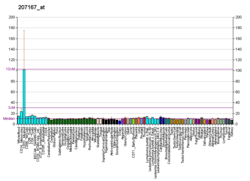Immunoglobulin superfamily, member 2 (IGSF2) also known as CD101 (Cluster of Differentiation 101), is a human gene.[5]
Further reading
- Rivas A, Ruegg CL, Zeitung J, et al. (1995). "V7, a novel leukocyte surface protein that participates in T cell activation. I. Tissue distribution and functional studies". J. Immunol. 154 (9): 4423–33. PMID 7722299.
- Ruegg CL, Rivas A, Madani ND, et al. (1995). "V7, a novel leukocyte surface protein that participates in T cell activation. II. Molecular cloning and characterization of the V7 gene". J. Immunol. 154 (9): 4434–43. PMID 7722300.
- Soares LR, Rivas A, Tsavaler L, Engleman EG (1997). "Ligation of the V7 molecule on T cells blocks anergy induction through a CD28-independent mechanism". J. Immunol. 159 (3): 1115–24. PMID 9233604.
- Bagot M, Martinel I, Charue D, et al. (1998). "CD101 is expressed by skin dendritic cells. Role in T-lymphocyte activation". Tissue Antigens. 50 (5): 439–48. doi:10.1111/j.1399-0039.1997.tb02898.x. PMID 9389317.
- Soares LR, Tsavaler L, Rivas A, Engleman EG (1998). "V7 (CD101) ligation inhibits TCR/CD3-induced IL-2 production by blocking Ca2+ flux and nuclear factor of activated T cell nuclear translocation". J. Immunol. 161 (1): 209–17. PMID 9647226.
- Bouloc A, Boulland ML, Geissmann F, et al. (2000). "CD101 expression by Langerhans cell histiocytosis cells". Histopathology. 36 (3): 229–32. doi:10.1046/j.1365-2559.2000.00827.x. PMID 10692025.
- Bouloc A, Bagot M, Delaire S, et al. (2001). "Triggering CD101 molecule on human cutaneous dendritic cells inhibits T cell proliferation via IL-10 production". Eur. J. Immunol. 30 (11): 3132–9. doi:10.1002/1521-4141(200011)30:11<3132::AID-IMMU3132>3.0.CO;2-E. PMID 11093127.
- Stipp CS, Kolesnikova TV, Hemler ME (2001). "EWI-2 is a major CD9 and CD81 partner and member of a novel Ig protein subfamily". J. Biol. Chem. 276 (44): 40545–54. doi:10.1074/jbc.M107338200. PMID 11504738.
- Strausberg RL, Feingold EA, Grouse LH, et al. (2003). "Generation and initial analysis of more than 15,000 full-length human and mouse cDNA sequences". Proc. Natl. Acad. Sci. U.S.A. 99 (26): 16899–903. doi:10.1073/pnas.242603899. PMC 139241. PMID 12477932.
- Suzuki Y, Yamashita R, Shirota M, et al. (2004). "Sequence comparison of human and mouse genes reveals a homologous block structure in the promoter regions". Genome Res. 14 (9): 1711–8. doi:10.1101/gr.2435604. PMC 515316. PMID 15342556.
- Meyer N, Petrella T, Poszepczynska-Guigne E, et al. (2005). "CD4+ CD56+ blastic tumor cells express CD101 molecules". J. Invest. Dermatol. 124 (3): 668–9. doi:10.1111/j.0022-202X.2005.23617.x. PMID 15737213.
- Kimura K, Wakamatsu A, Suzuki Y, et al. (2006). "Diversification of transcriptional modulation: large-scale identification and characterization of putative alternative promoters of human genes". Genome Res. 16 (1): 55–65. doi:10.1101/gr.4039406. PMC 1356129. PMID 16344560.
External links
|
|---|
| 1-50 | |
|---|
| 51-100 | |
|---|
| 101-150 | |
|---|
| 151-200 | |
|---|
| 201-250 | |
|---|
| 251-300 | |
|---|
| 301-350 | |
|---|




